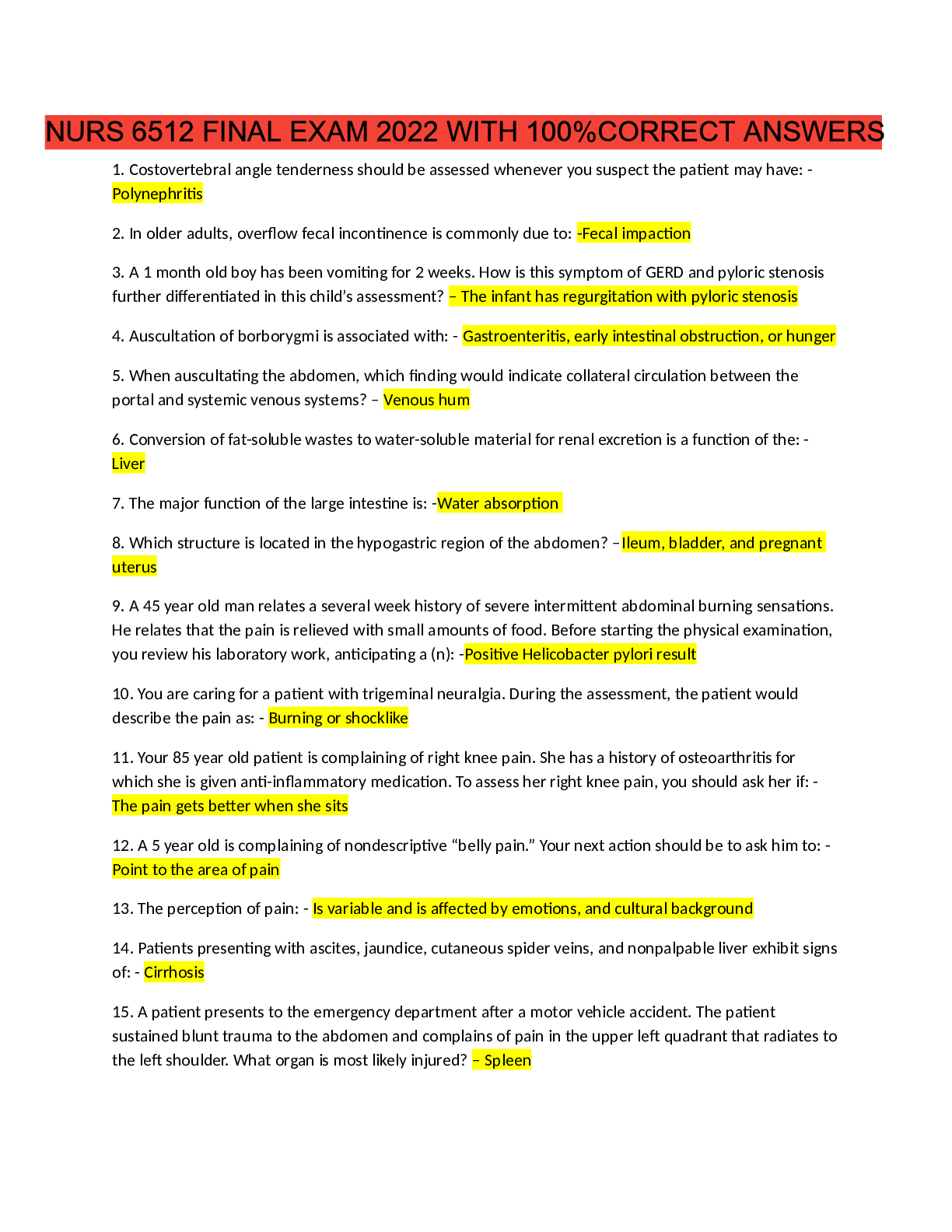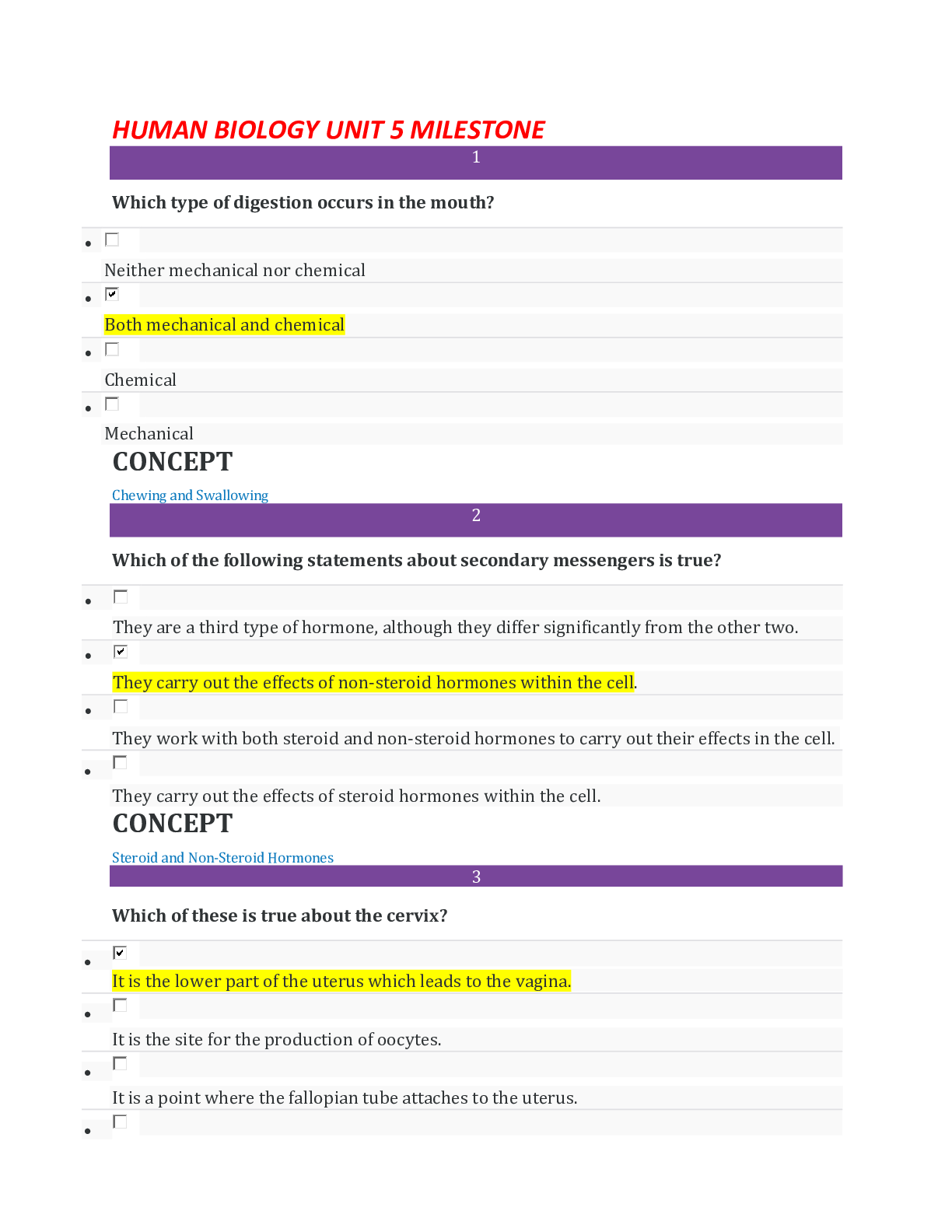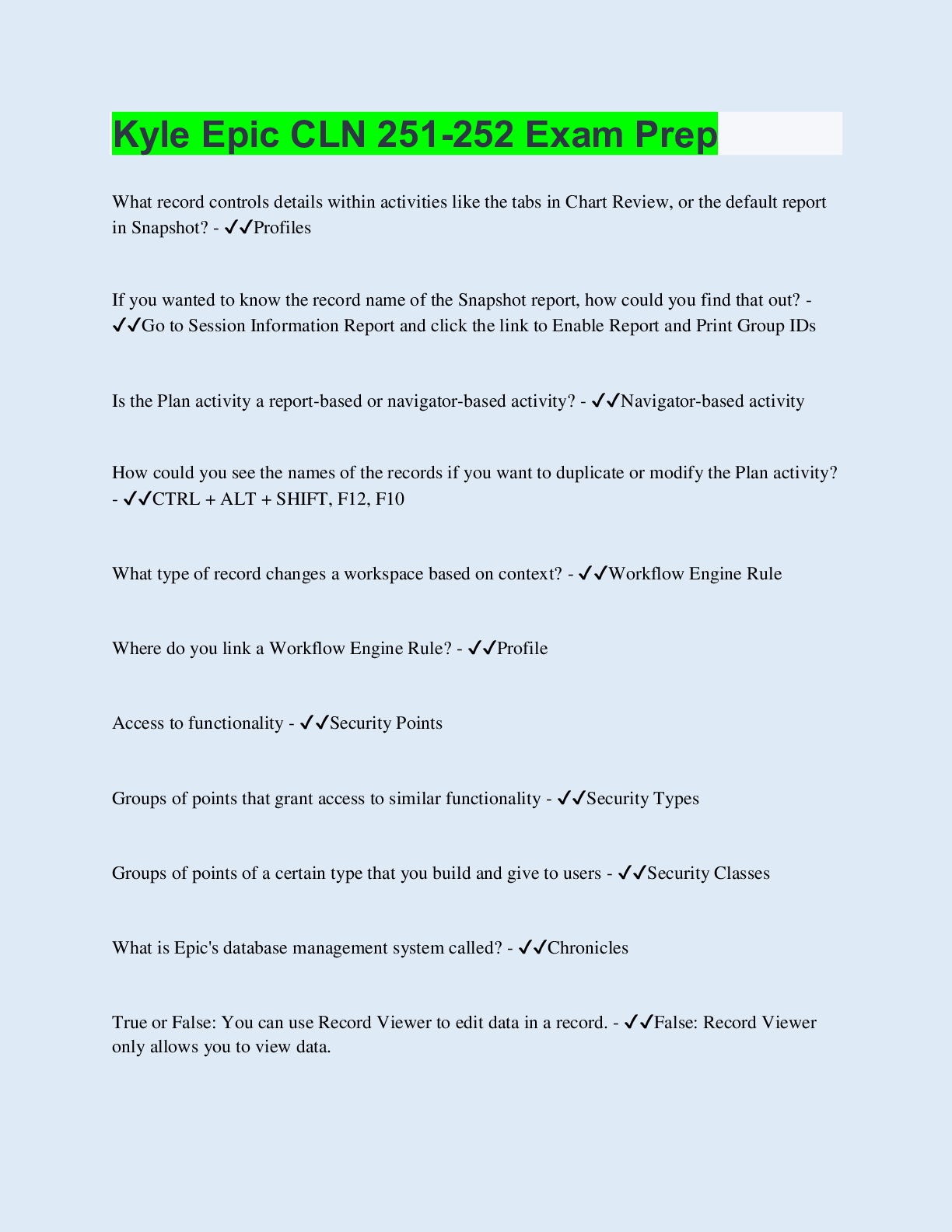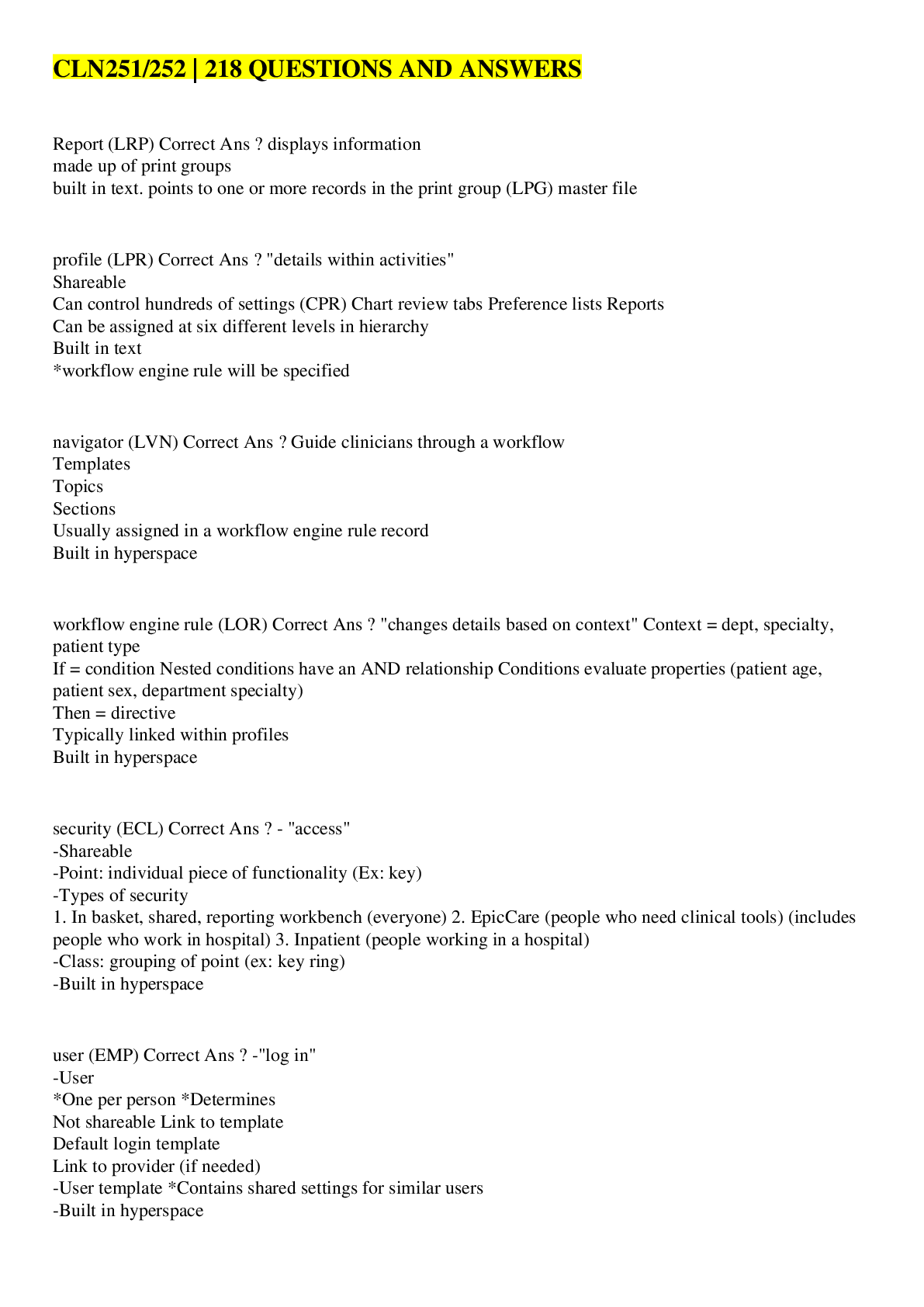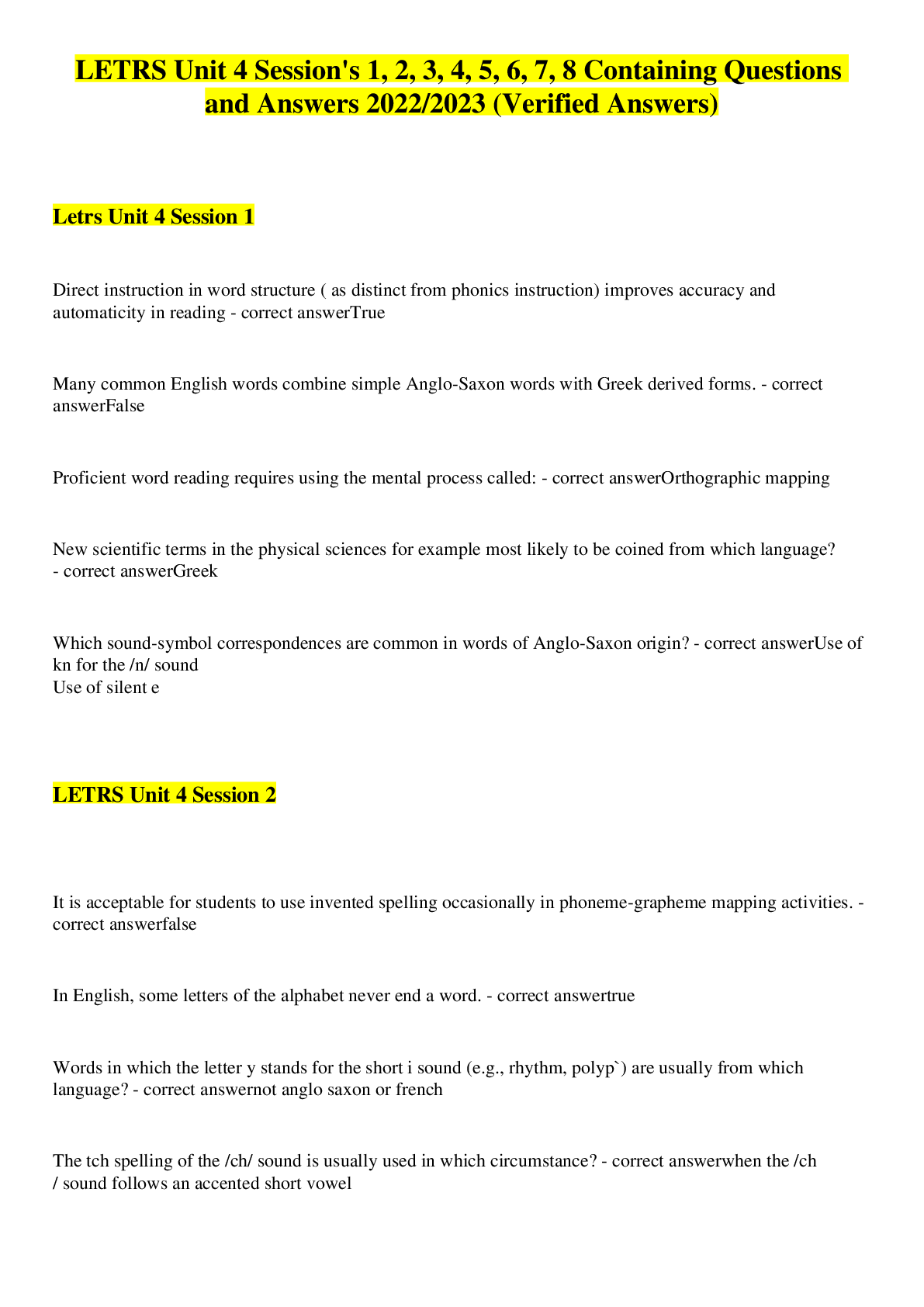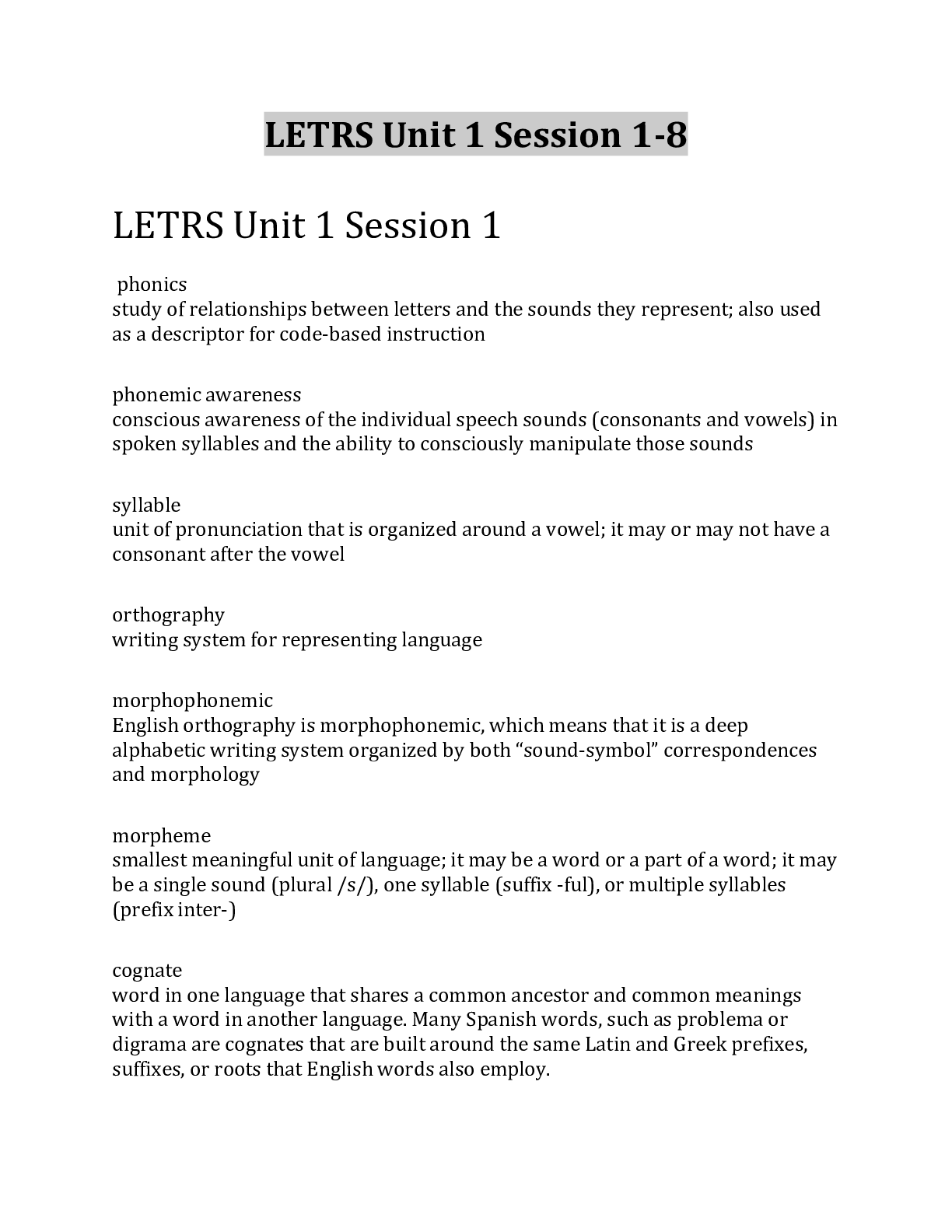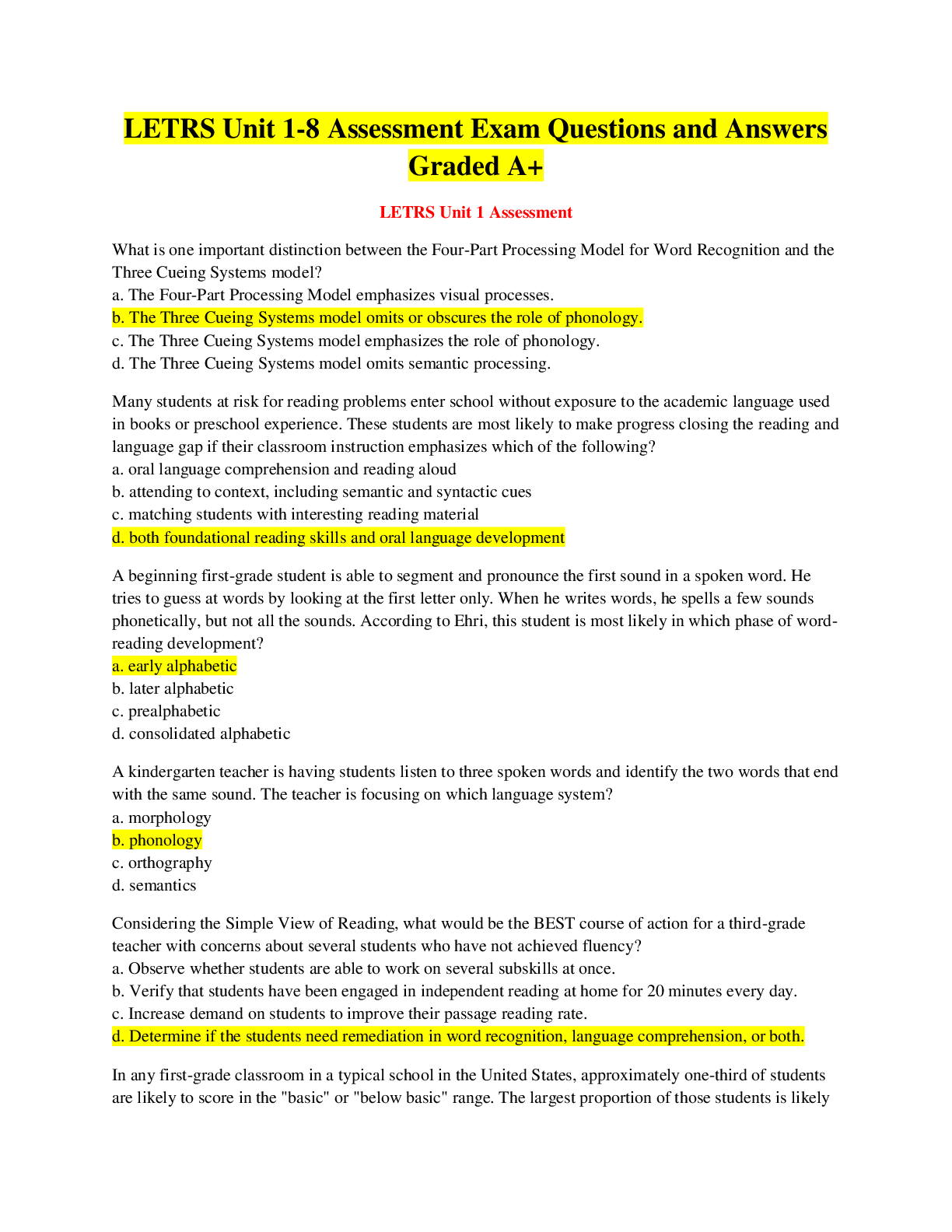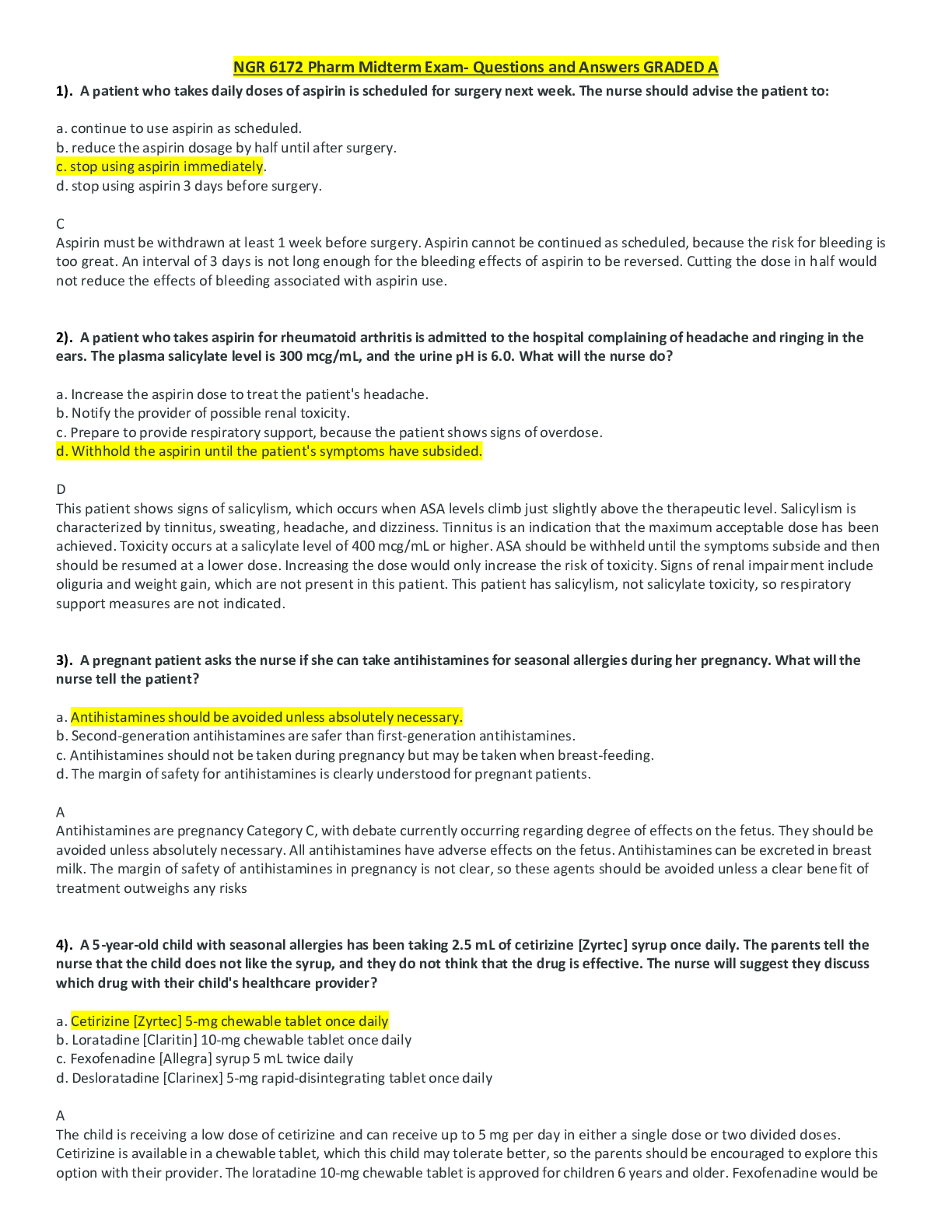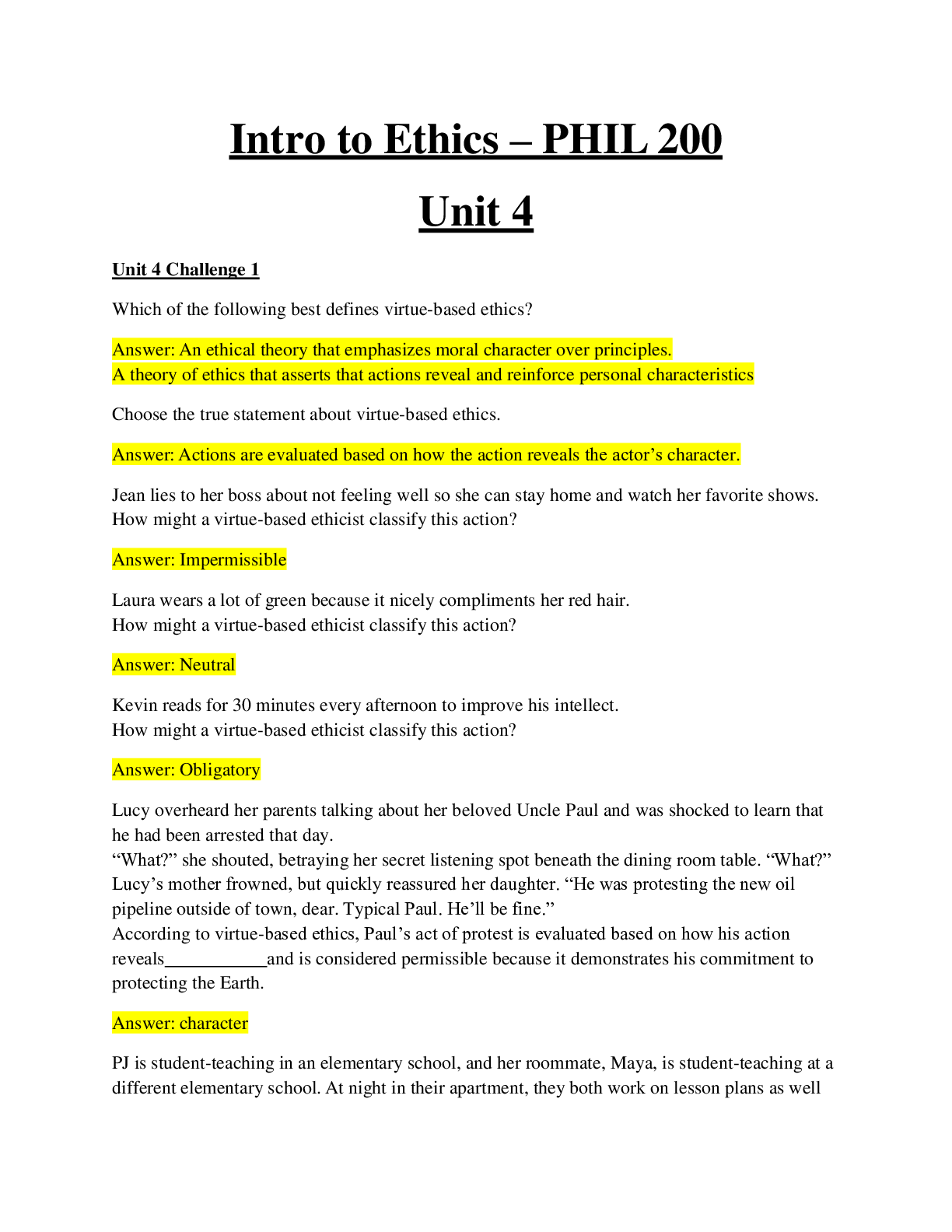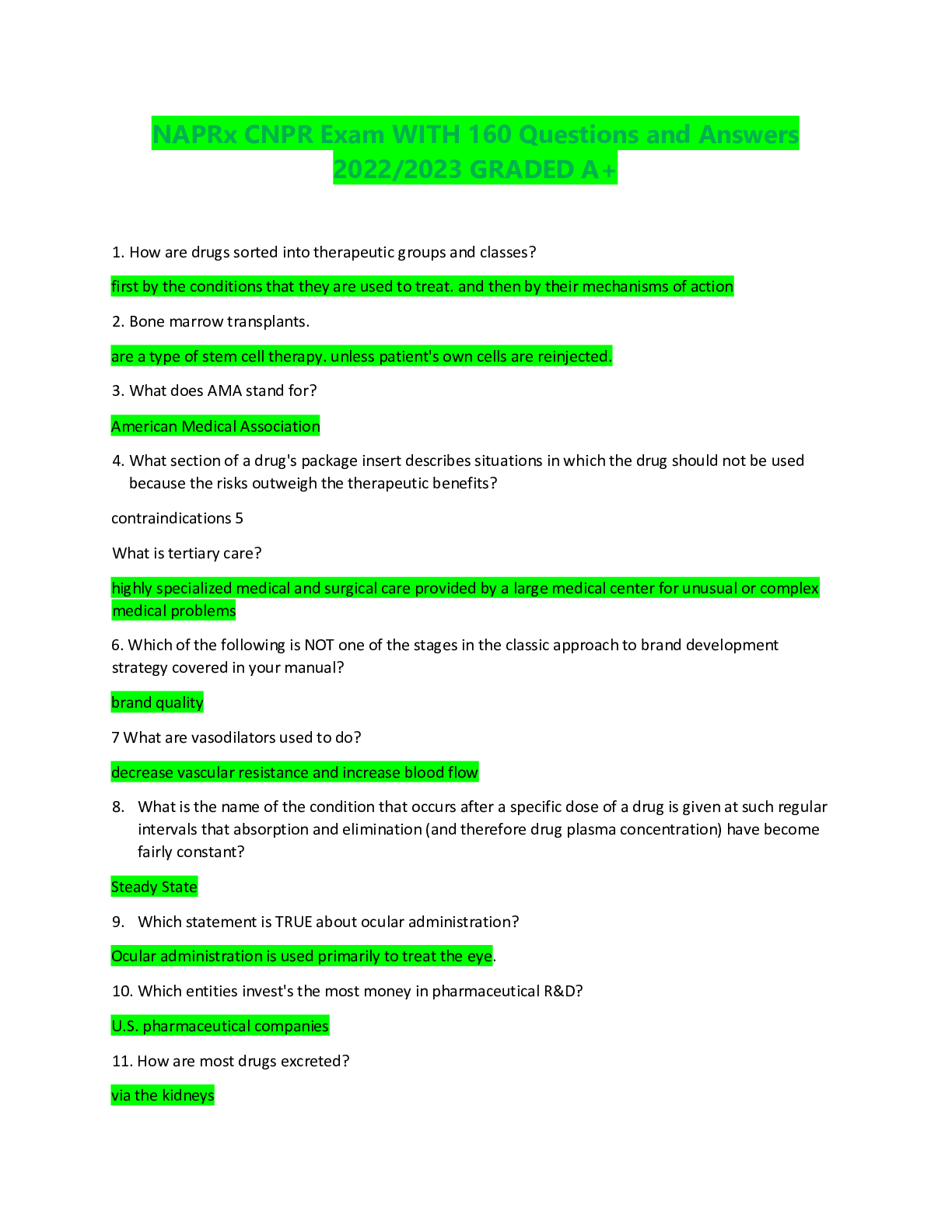*NURSING > EXAM > BIO 669 Quiz 4- Cardiovascular Questions and Answers latest 2022/2023,100% CORRECT (All)
BIO 669 Quiz 4- Cardiovascular Questions and Answers latest 2022/2023,100% CORRECT
Document Content and Description Below
BIO 669 Quiz 4- Cardiovascular Questions and Answers latest 2022/2023 1. Which of the following conditions is the most immediately at risk for serious complications? a. Unstable angina b. Pri... nzmetal angina c. STEMI d. NSTEMI 2. Thromboangiitis obliterans (Buergers disease) is an autoimmune condition that is: a. A result of over activation of the intrinsic and extrinsic clotting system systemically b. Characterized by attacks of vasospasm in the small arteries and arterioles of the fingers and toes c. Strongly associated with smoking d. Associated with janeway lesions and Oslers Nodes 3. Which of the following is not a systemic disease that is associated with Raynaud's Phenomenon? a. Congestive heart failure b. Collagen vascular diseases such as scleroderma c. Pulmonary hypertension d. Myxedema or smoking 4. Rheumatic fever, and subsequent heart complications in 10% of individuals is left untreated arises from: a. Bacteria, fungi, rickettes or viral infections b. Sterile, autoimmune reaction (no infection involved) c. Dyslipidemia d. Group A beta-hemolytic strep pharyngitis 5. Which of the following is NOT a primary factor in determining preload? a. Venous return during diastole b. End systolic volume c. Total peripheral (systemic) resistance d. All of the above are primary factors of preload 6. Which of the following statements are incorrect? a. The mean arterial pressure is the average force of pushing blood through the systemic circuit. b. The pulse pressure is the difference between systolic and diastolic pressures c. A decrease in aortic compliance increases its stiffness and thus can lead to an increase in pulse pressures d. Prostacyclins, which are diminished by NSAIDs, are vasoconstrictors. 7. Which of the following is incorrect regarding the isometric contraction phase of the cardiac cycle? a. Blood does not flow through the heart at this time. b. The atria are contracting c. The valves are closed d. It occurs during ventricular systole 8. The resistance of movement of blood from the left ventricle to the aorta is termed the: a. Ejection fraction b. Compliance c. Preload d. Afterload 9.Natriuretic peptides act by: a. Stimulates secretion of Na+ (and thus decreases urine volume) from the kidneys B. Stimulated the release of Na+ (thus increases urine volume) from the kidneys C. Increases vascular smooth muscle contraction (vasoconstriction D. Stimulates increased heart rate, contractility, and cardiac output 10. The double layered serous membrane surrounding the heart that functions to minimize friction from the heart movement is the: A. Myocardium B. Endocardium C. Peritoneum D. Pericardium 11. Prinzmetal angina is a. A transient ischemia of the myocardium that occurs unpredictably b. Myocardial ischemia that may not cause detectable symptoms c. Ischemia that occurs after a predictable amount of exercise d. The rupture of an unstable plaque 12. Progressive venous distension of the head and upper extremities resulting from growth of a cancerous tumor on the right mainstem bronchus is best described clinically as: A. Deep vein thrombosis B. Spinal shock C. Superior vena cava syndrome D. Carcinoid syndrome 13. The most common cause of aneurysm is A. External Hematoma B. Atherosclerosis with hypertension C. Genetics D. Congestive heart failure 14. An atherosclerotic area that has ruptured is termed A. Fibrous plaque B. Complicated plaque C. Fatty streak D. Aneurysm 15. The PR interval represents the time from: A. The onset of atrial systole to the completion of atrial diastole B. The onset of atrial systole to the onset of ventricular diastole C. The onset of atrial systole to the onset of ventricular diastole D. The onset of atrial systole to the onset of ventricular systole 16. The circumflex artery off of the left coronary artery A. Left atrium and ventricle B. The two atria C. The two ventricles D. The aorta and the pulmonary artery 17. The structure that connect the leaflets/cusps and help to prevent prolapse of the AV valves is the A. Chordae tendineae and papillary muscles B. Cardiomyocytes C. Interventricular septu D. Coronary ostia A. mitral valve prolapse would be heard during A. Ventricular systole B. Atrial systole C. Isovolumetric relaxation phase D. Ventricular diastole 19. Hypertensive crisis (malignant hypertension) is best defined as: A. An advancing failure of systemic circulation as the heart weakens B. Rapidly progressive hypertension with a diastolic pressure of 140 mmHg or more C. A pulse pressure of greater than 60 D. Blood pressure readings consistently greater than 140/90 mmHg 20. Intermittent claudication is: A. Caused by coronary artery disease B. A sign of peripheral artery disease C. An attack of vasospasm brought on by the cold D. A result of peripheral neuropathy A. patient presents with fever, diffuse microemboli presenting as petechial lesions, painful lesions on the fingertips and what looks like non-tender bruising on both hands is most indicative of which disease process? A. Infective endocarditis B. Rheumatic fever C. HIV infection D. Tuberculosis 22. Stroke volume: A. Does not affect the cardiac index B. Is equal to ESV - EDV C. Does not vary much D. None of the above are true A. T wave relates to and shortly precedes the closure of the valves. A. Ventricular depolarization, AV B. Ventricular depolarization, SL C. Ventricular repolarization, AV D. Ventricular repolarization, SL E. None of the above 24. How much of the oxygen carried by hemoglobin in the blood is actually transferred to the myocardium? A. 10-20% B. 40-50% C. 70-75% D. 100% 25. The key regulator determining if a muscle, such as cardiac muscle, contracts or not is the presence of: A. Ca++ B. ATP C. K+ D. Epinephrine 26. Myocardial hibernation is best described as: A. Myocardial cells that are persistently ischemic and undergo metabolic adaptation to prolong survival B. Hypertrophy that occurs with loss of contractile function D. Temporary loss of contractile function that persists for hours to days after restoration of perfusion E. Fibroblast proliferation and severe inflammatory response thrombus is a blood clot that remains attached to a vessel wall. Which of the following is NOT one of the main factors as proposed by Virchow? A. Obesity B. Venous Stasis C. Venous Endothelial damage D. Hypercoagulable states 12-year-old boy presenting with complaints of fever, pink macular rash on the trunk and finding of diastolic murmur on the exam should be investigated for possible: A. Restrictive cardiomyopathy B. Dilated(congestive) cardiomyopathy C. Rheumatic fever D. Tuberculosis 29. The decreased or inability to generate action potential due to hyperpolarization or continued closure of inactivation gates is termed: A. Rhythmicity B. Quiescence C. Refractory period D. Afterload 30. All of the following antihypertensive agents would be appropriate first line treatments EXCEPT: a. Calcium channel blockers b. Beta blockers c. Ace inhibitors or ARBs d. Diuretics such as Thiazide 31. STEMI would most likely present with: a. Inverted T waves and Q waves b. Peaked T waves c. Marked ST segment elevation d. Absence of troponin I or T 32. What area is of the myocardium is affected by STEMI? a.Transmural (entire wall thickness) b.Subendothelial area c.Just the right side d.Only the atria 33. The disorder of the myocardium that expands overall intracardiac volume and leads to heart failure is: a. Dilated (congestive) cardiomyopathy b. Hypertrophic cardiomyopathy c. Hypertensive cardiomyopathy d. Valvular hypertrophic cardiomyopathy e. Restrictive cardiomyopathy 34. Which of the following is a correct statement regarding baroreceptor reflex activity on the heart? a.A drop in blood pressure would result in release of natriuretic peptides b.A drop in blood pressure would result in reflex to decrease heart rate, contractility, and peripheral resistance c.A rise in blood pressure would result in reflex to increase heart rate, contractility , and peripheral resistance d.A drop in blood pressure would result in reflex to increase heart rate, contractility, and peripheral resistance 35. The development of atherosclerotic plaques involve the formation of foam cells, which are best described as: A. Transformed fibroblasts B. Cytokine secreting adipose cells C. Macrophage that engulf oxidized LDL D. Endothelial cells that produce the gas nitric oxide 36. Which of the following statements regarding compliance and elasticity is correct? a.Compliance and elasticity are directly related (i.e. as one increases, so does the other) b.Elasticity is the ease by which a wall, like a vessel wall, will stretch in response to increases in pressure c.A decrease in compliance, such as the aorta, means that it is stiffer and less easy to expand d.As elasticity increases, the ease by which a vessel can expand increases as well ++ 37. The isovolumetric contraction phase of the cardia life cycle occurs: A. During atrial systole B. When the AV valves are closed C. When the SL valves are open D. During diastole 38. Choose the correct conduction pathway for a cardiac action potential: A.SA node to AV node to bundle branches to othe Bundle of HIS to purkinje fibers B.SA node to AV node to Purkinje fibers to bundle of HIS to bundle branches C.SA node to bundle of HIS to AV node to bundle branches to purkinje fibers D.SA node to AV node to bundle of HIS to bundle branches to purkinje fibers 39. Which of the following vessels carries oxygenated blood? A. Inferior vena cava B. Superior vena cava C.Pulmonary artery D.Pulmonary Vein E.Inferior vena cava and superior vena cava 40. Which of the following valve abnormalities is heard during diastole (diastolic murmur)? (Hint: Think when blood should and should not flow past these structures in terms of diastole/systole) A. Aortic stenosis B. Mitral Valve Prolapse C. Tricuspid Regurgitation D. Mitral Stenosis 41. Which of the following can form an embolus? A. Fat B.Amniotic Fluid C.Air D.Bateria, especially within clots E.All of the above can become an embolus 42. An increase in Ca++ influx, brought about by catecholamines binding to beta receptors on the myocardium will result in: A. An increase in cardiac contractility B. An increase in speed of heart rate and electrical conduction through the heart C. An increase in preload D. Both an increase in contractility and heart rate / conduction speed 43. Myocardial infarction that shows an inverted T wave and ST segment depression is most likely a result of: A. Non-STEMI (Non-ST elevation myocardial infarction) B.STEMI (ST segment elevation myocardial infarction) C.Transmural myocardial infarction D.Myocardial stunning 44. The term vegetation as discussed in the cardiovascular lecture refers to: a. Infiltration of sterile thrombi by bacteria b. Myocardial cells that are inactive due to chronic ischemia c. Temporarily non-contractile myocardial cells following reperfusion d. Hemorrhagic, non-tender lesions on the hands 45. The T wave is an electrical recording resulting from: a. Ventricular depolarization b. Ventricular repolarization C. Atrial depolarization D. Atrial repolarization 46. As a result of the Starling effect, stroke volume should increase following an increase in: a. Mean arterial pressure (MAP) b. Heart rate c. Sympathetic activity d. Afterload e. Preload 47. The light band in cardiac and skeletal muscle that varies by degree of contraction is termed the: a. I band b. A band c. M line d. Z disc 48. A result of the action potential’s long duration in stimulating muscle is that: A. Summation cannot occur regardless of how strong the stimulus B. Cardiac muscle cannot go into tetanus and lock up in contracted position C. Cardiac muscle has a long refractory period D. All of the above are true. 49. What is the effect of decreasing O2 and increasing CO2 levels (hypoxemia) on myocardial contractility? A. Only decreases contractility B. Only increases contractility C. Decreases at less severe (O2 sat>50%) but increases at more severe hypoxemia D. Increases at less severe (O2 sat>50%) but decreases at more severe hypoxemia. 50.A common and overlooked cause of chronic orthostatic hypertension is: A. Abdominal aneurysm B. Cerebral aneurysm in the Circle of Willis C. Increased peripheral resistance caused by peripheral vascular disease D. Autonomic neuropathy in persons with diabetes. 51.Secondary hypertension is best described as: A. Of unknown causes B. As a result of an identifiable condition such as pheochromocytoma. C. The most common cause of hypertension in the United States. D. Not likely to affect the heart. 52. Which characteristic changes should the nurse keep in mind while caring for a patient with left heart failure? As left heart failure progresses: A. Left ventricular preload increases. B. Systemic vascular resistance. C. Left end- diastolic volume decreases. D. The pulse pressure widens. 53. Which of the following factors is NOT commonly associated with the development of hypertension? A.Obesity B.Insulin resistance C.Altered Natriuretic peptide hormones and salt retention D.High dietary levels of Ca++ K+ and Mg+ 54. Your patient with a history of coronary artery disease and regular chest pain brought on by exercise of certain duration now has significant and worsening chest pain, sweating, and mild dyspnea. Which of the following statements is true regarding this patient? A. He has unstable angina B. He is at significant risk of an infarction soon C. The pain is a signal that an atherosclerotic plaque has just ruptured in a coronary vein D. All of the above are true 55. The disorder of the myocardium that is characterized by normal systolic but increased diastolic pressure due to abnormal filling of either or both ventricles and normal wall thickness is: A. Dilated (congestive) cardiomyopathy B. Hypertrophic cardiomyopathy C. Valvular hypertrophic cardiomyopathy D. Restrictive cardiomyopathy 56. An aortic semilunar valve prolapse would best be heard during: A. Ventricular systole B. Ventricular diastole C. The entire cardiac cycle D. None of the above 57. In cardiac muscle, Na+ inactivation gates will open again following another depolarization to potentially occur when: A. The membrane potential reaches 0mV. B. When the membrane returns to resting potential C. K+ channels are closed D. Membrane potential reaches threshold 58. Which of the following valvular abnormalities does NOT result in a potential for dyspnea and pulmonary edema? A. Mitral valve prolapse B. Tricuspid valve regurgitation C. Aortic Stenosis D. Mitral Stenosis 60. Which of the following is not a systemic disease that is associated with Raynaud phenomenon? A. Congestive heart failure B. Collagen vascular disease such as scleroderma C. Pulmonary hypertension D. Myxedema or smoking 61. The is an opening for venous drainage to empty into the right atrium: A. Aortic ostia B. Circumflex vein C. Great cardiac vein D. Coronary sinus 62. Which of the following is NOT a risk factor for varicose veins? A. Age > 40 yrs B.High estrogen levels (pregnancy or BCP) C.Obesity D.Prior injury in the vein/leg E.All of the above are risk factors for varicose veins 63. The cells of the cardiac conduction system (SA node, AV node, Purkinje fibers) have a unique property that allows a steady leakage toward depolarization during the diastolic phase of the cardiac cycle. This property is called: A. Automaticity B. Excitability C. Refractory periods D. Preload 64. Arterial chemoreceptors within the aortic arch and carotid arteries: A. Increase heart rate, stroke volume and blood pressure in response to decreased oxygen or increased CO2 levels B.Will stimulate vascular smooth muscle constriction in response to low oxygen levels C.Detects oxygen, but not CO2 or hydrogen ion levels in the plasma D.Triggers the release of insulin when hyperglycemia is detected 65. The portion of troponin that binds the troponin complex to actin and is released into the plasma during cardiac cell damage(and is a useful indicator of an acute MI) is troponin: A. I B. M C. C D. T 66. As a wave of action potentials travel from the atria to the ventricles, it is momentarily delayed by about 0.1 second as a result of slow conduction through the: A. SA node B. AV Node C. Atrioventricular bundle (of his) D. Left and right bundle branches E. Purkinje fibers 67. The area that connects cardiac fibers to one another as well as electrically connecting them is termed: A. The z disc B. The M line C. The intercalated disk D. The A band 68. Which of the following effects does the renin angiotensin aldosterone system (RAAS) NOT directly affect in the development of hypertension? A. Salt, water and increased vascular resistance B. Endothelial dysfunction, insulin resistance, and platelet aggregation C. Arteriolar remodeling making the increase vascular resistance permanent D. Increase in heart rate and stroke volume, thus increasing cardiac output 69. Myocardial stunning refers to the A. Myocardial cells that are persistently ischemic and undergo metabolic adaptation to prolong survival B. Hypertrophy that occurs with loss of contractile function C. Temporary loss of contractile function that persists for hours to days after restoration of perfusion D. Fibroblast proliferation and severe inflammatory response 70. Identify the correct path of blood through the heart and lungs A. Vena cava → L Atrium → Tricuspid valve → L ventricle → Pulmonary artery→ Pulmonary vein → R atrium → Mitral valve → R Ventricle B. Vena Cava → Right atrium → Tricuspid valve → Right ventricle → Pulmonary vein → Pulmonary artery → Left Atrium → Mitral valve → Left Ventricle → Aorta C. Vena Cava → R Atrium → Tricuspid valve → Right ventricle → Pulmonary artery- Pulmonary vein → L Atrium → Mitral valve → L Ventricle → Aorta D. Vena Cava → R atrium → Mitral valve → R Ventricle → Pulmonary artery → Pulmonary vein → L atrium → Tricuspid valve → L Ventricle → Aorta 71. The innermost layer of the heart wall (inner lining layer) is the A. Epicardium B. Myocardium C. Endocardium D. Pericardium 72. Which of the following is most likely to increase ejection fraction? A.Sympathetic nervous system activation B.Parasympathetic nervous system activation C.An acute MI affecting the left ventricle D.Increased afterload 73. The volume/pressure inside the ventricle at the end of diastole is termed the: A. Ejection fraction B. Cardiac output C.Preload D.Afterload 74. Which of the following in an INCORRECT statement related to Poiseuille’s law? A. The resistance to flow is directly proportional to the vessel length B. The resistance to flow is inversely proportional to blood viscosity. C. The resistance of flow is inversely related to the radius of tube to the 4th power. D. The flow of blood is directly to the flow of the lumen 75. Myocardial remodeling of the affected area is a process that results in: A. Myocardial cells that are persistently ischemic and undergo metabolic adaptation to prolong survival B. Hypertrophy that occurs with loss of contractile function C. temporary loss of contractile function that persists for hours to days after restoration of perfusion D. Fibroblast proliferation and severe inflammatory response 76. Which of the following statement is correct? A. The resistance to blood flow increases as the cross sectional area increases B. The speed of blood flow decreases as the cross sectional area increases C. The resistance to flow is indirectly proportional to blood viscosity D. The resistance to blood flow of many vessels increases if they are in parallel as compared to the area around 77. Which of the following cells would have the slowest rate of depolarization if isolated and in the absence of any external stimulation? a. Atrioventricular node cells b. Purkinje fiber cells c. Sinoatrial node cells d. They would all have nearly the same rate of depolarization 78. A patient presents with fever, diffuse microemboli presenting as petechial lesions, painful lesions on the fingertips and what looks like non-tender bruising on both hands is most indicative of which disease process? a. Infective endocarditis b. Rheumatic fever c. HIV infection d. Tuberculosis [Show More]
Last updated: 1 year ago
Preview 1 out of 37 pages
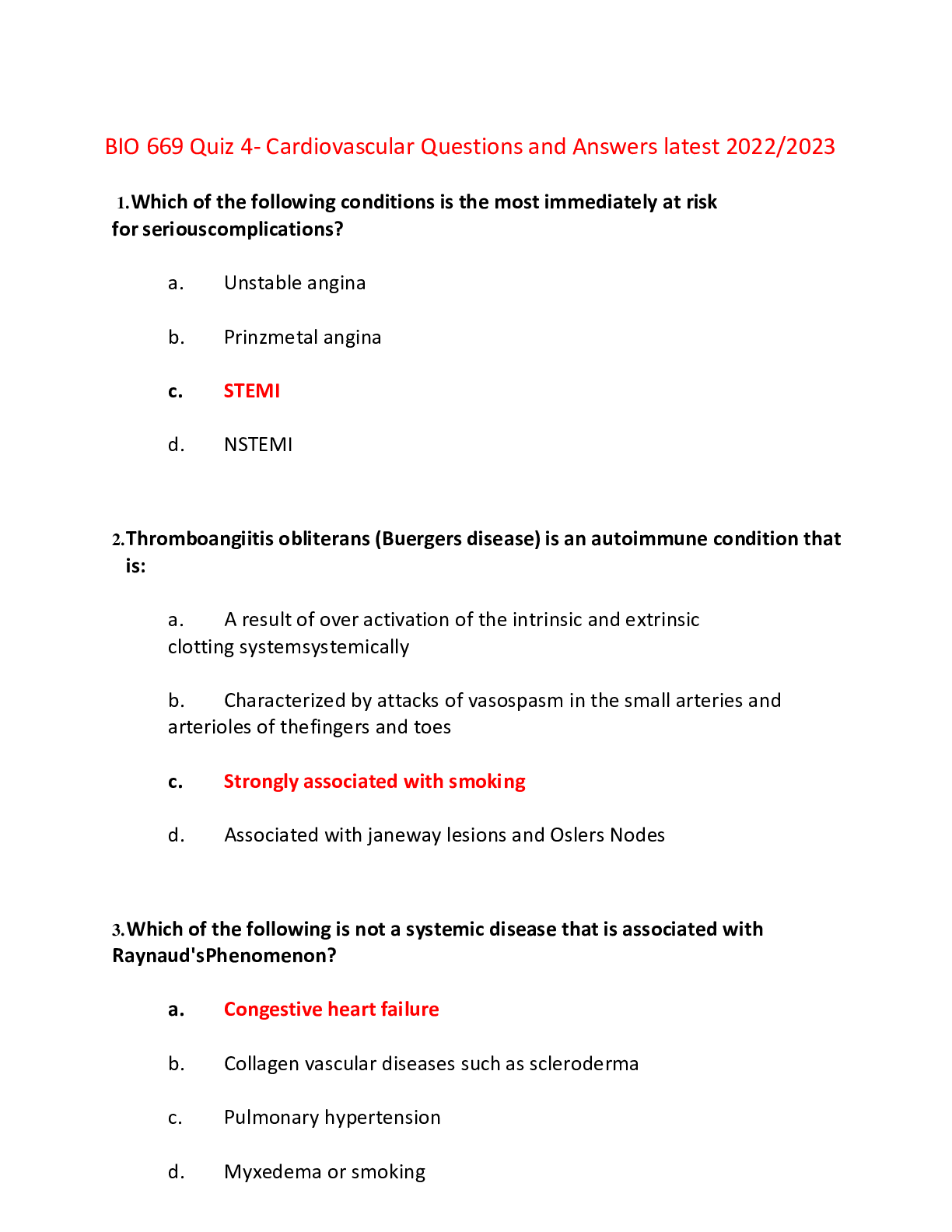
Reviews( 0 )
Document information
Connected school, study & course
About the document
Uploaded On
Nov 23, 2022
Number of pages
37
Written in
Additional information
This document has been written for:
Uploaded
Nov 23, 2022
Downloads
0
Views
26




